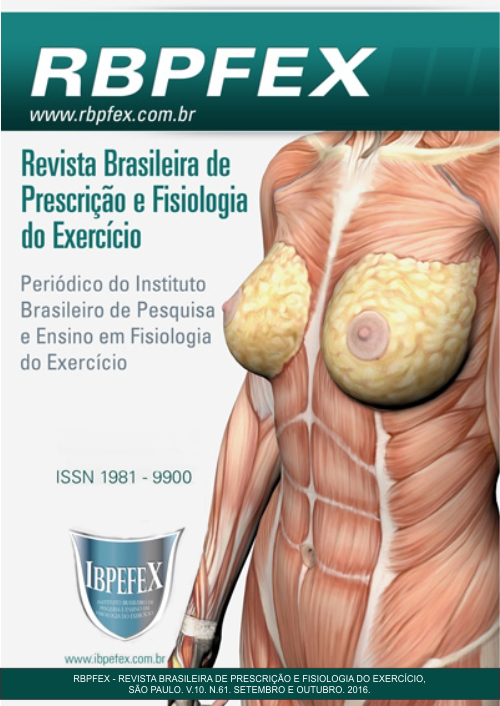Appliance and analysis of the aerobic and resistance exercise sessions’ effects applied in the outdoor gymonthe blood hypertension control
Abstract
The objective of this study was to apply and analyze the effects of 12 aerobic and resistance physical exercise (PE) sessions, for the control and/or treatment of arterial hypertension (HTN). The HTN is a silent disease,that affects a large part of the Brazilian population and its effects are harmful especially to the heart and arteries. The HTN, in most cases, has an idiopathic origin, and the treatment that has been being studied is not pharmacological, in other words,is based on a healthy lifestyle, that includes the regular practice of PE. The PE program of such study was prescribed by the Borg scale, which the intensity of the aerobic PE is between a 12-14 range and the resistance PE intensity is in the 11 range by the scale. The study sample is constituted by 14 hypertensive inactive women aged 44-74 years who were in pharmacological remedies treatment. The blood pressure (BP) was measured before and after the workout. The results obtained from the research’s surveywere averaged systolic blood pressure (SBP) by a 7.96 (6.2%) difference and diastolic blood pressure (DBP) by 3.96 (5.1%) with statistical significance according to the Student t-Test (p <0.05). The study was concluded as a positive result for the research.
References
-American College ofSports Medicine. Diretrizes do ACSM para os testes de esforço e sua prescrição. 7ª edição. Guanabara Koogan. 2007.
-Borg, G. Escalas de Borg para a dor e o esforço percebido. Manole. 2000.
-Borges, H.P.; Cruz, N.C.; Moura, E.C. Associação entre Hipertensão Arterial e Excesso de Peso em Adultos, Belém, Pará, 2005. Arq. Bras. Cardiol. Vol.91. Núm. 2. 2008.
-Brasil. Ministério da Saúde. Cadernos de atenção básica: Hipertensão arterial sistêmica. 1ª edição. Brasília. 2006.
-Brum, P.C.; Forjaz, C.L.M.; Tinucci, T.; Negrão, C.E. Adaptações agudas e crônicas do exercício físico no sistema cardiovascular. Revista Paulista de Educação Física. Vol. 18. p. 21-31. 2004.
-Guyton, A. C. M.D. Fisiologia Humana. Rio de Janeiro. Guanabara Koogan. 1988.
-Marins, J.C.B.; Giannichi, R. S. Avaliação e prescrição de atividade física: guia prático. 3ªedição. Rio de Janeiro. Shape. 2003.
-Monteiro, W. Personal Training. Manual para avaliação e prescrição de condicionamento físico. 4ª edição. Rio de Janeiro. Sprint. 2004.
-Negrão, C.E.; Barretto, A.C.P. Cardiologia do exercício: do atleta ao cardiopata. 2ª edição São Paulo. Manole. 2006.
-Nieman, D.C.; Dr. P. H. Exercício e saúde. 1ª edição. São Paulo. Manole. 1999.
-Nieman, D.C. Exercício e saúde: teste e prescrição de exercícios. São Paulo. Manole. 2011.
-Pitanga, F. J. G. Epidemiologia da atividade física, do exercício e da saúde. 3ª edição. São Paulo. Phorte. 2010.
-Polito, M.D. Prescrição de exercícios para saúde e qualidade de vida. São Paulo. Phorte. 2010.
-Robergs, R.A.; Roberts, S.O. Princípios fundamentais de fisiologia do exercício: para aptidão, desempenho e saúde. São Paulo. Editora. 2002.
-Rondon, M. U.P.; Brandão; B.; Chakur, P. Exercício físico como tratamento não-farmacológico da hipertensão arterial. Rev Bras Hipertens. Vol. 10. Núm. 2. 2003.
-Sociedade Brasileira de Cardiologia. V Diretrizes Brasileiras de Hipertensão Arterial. Arq Bras Cardiol. 2007.
-Sociedade Brasileira de Cardiologia. VI Diretrizes Brasileiras de Hipertensão Arterial. Arq Bras Cardiol.2010.
-Sociedade Brasileira de Cardiologia; Sociedade Brasileira de Hipertensão; Sociedade Brasileira de Nefrologia. III Consenso Brasileiro de Hipertensão arterial. Arq Bras Endocrinol Metab. Vol.43. Núm. 4.1999.
Authors who publish in this journal agree to the following terms:
- Authors retain the copyright and grant the journal the right of first publication, with work simultaneously licensed under the Creative Commons Attribution License BY-NC which allows the sharing of the work with acknowledgment of the authorship of the work and initial publication in this journal.
- Authors are authorized to enter into additional contracts separately for non-exclusive distribution of the version of the work published in this journal (eg, publishing in institutional repository or book chapter), with acknowledgment of authorship and initial publication in this journal.
- Authors are allowed and encouraged to post and distribute their work online (eg, in institutional repositories or on their personal page) at any point before or during the editorial process, as this can bring about productive change as well as increase impact and impact. citation of published work (See The Effect of Free Access).






